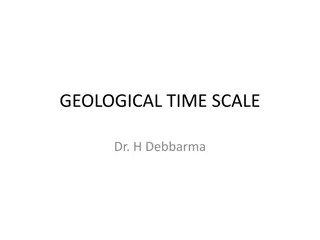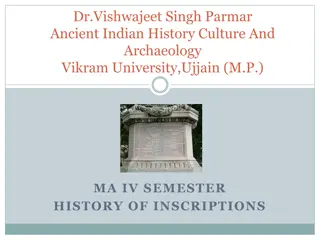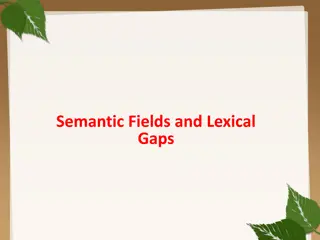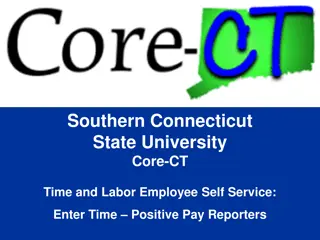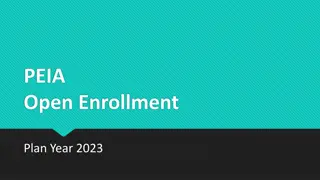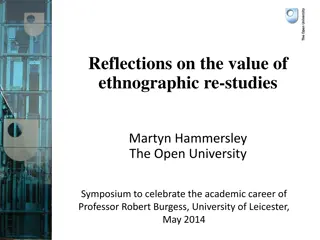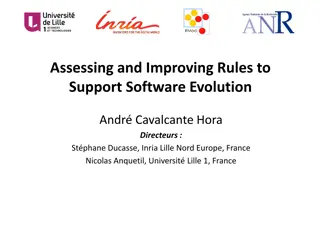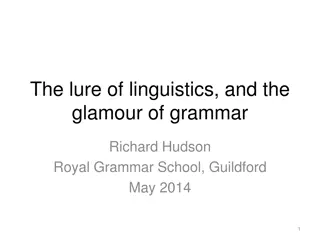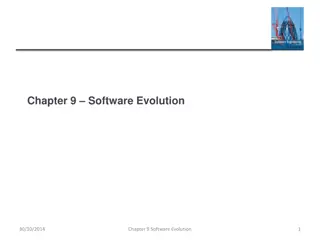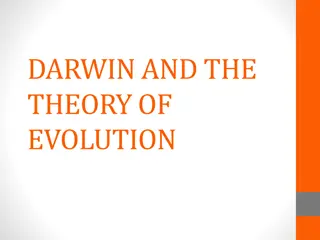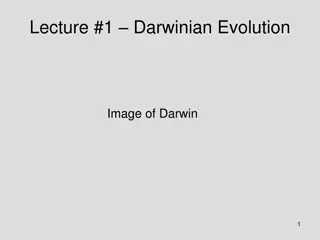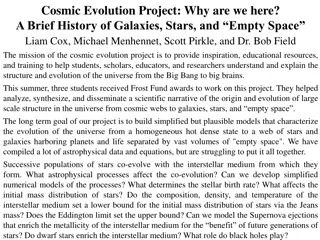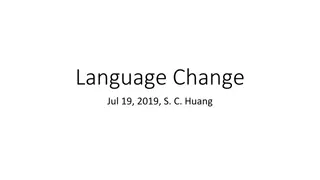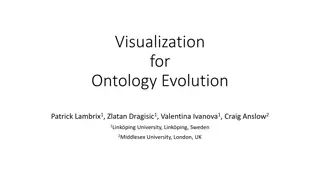Exploring Language Evolution: How Language Changes Over Time
Delve into the fascinating topic of language evolution by understanding how language has transformed over the years, reflecting changes in our lives, experiences, and cultures. Engage in activities to grasp the shifts in vocabulary usage and expressions, such as interviewing individuals about their language experiences and exploring unfamiliar words with a thesaurus challenge. Additionally, immerse yourself in the character description of the Dreamgiver to enhance your understanding of expanded noun phrases in English Visual Literacy.
Download Presentation

Please find below an Image/Link to download the presentation.
The content on the website is provided AS IS for your information and personal use only. It may not be sold, licensed, or shared on other websites without obtaining consent from the author. Download presentation by click this link. If you encounter any issues during the download, it is possible that the publisher has removed the file from their server.
E N D
Presentation Transcript
Monday 13thJuly 2020 Grammar Understanding how language has changed over time.
Monday 13thJuly 2020 WALT: learn and revise why language has changed over time Success Criteria: one video to remind yourself of the main ways language changes over time three activities
https://www.bbc.co.uk/bitesize/articles/zfvbcqt Learn Language is constantly adapting and changing to reflect our changing lives, experiences and cultures. This change allows us to talk about new ideas, inventions and technologies. It's not just the words themselves which change; the way in which we use them can shift too. Watch the short clip to learn more. Practise Activity 1 Complete the quick quiz to see what you've learned about language change.
Activity 2 Interview a member of staff about language change. You could do this in person or the interview could be over the phone or via the internet. Aim to write at least six questions. Here are some sample questions to get you started: What present day words did not exist when you were young? What words did you use a lot when you were younger that are no longer frequently used in the present day? Do you remember any slang words you used as a teenager? Add three more questions to the list. Write down their answers and make notes as they are speaking. What have you learned about language change? Do any of their answers lead to more questions? Repeat this for some more of your words from activity two.
Activity 3 Using some of the unfamiliar words that you discovered in activity two, take the thesaurus challenge using this activity sheet from Twinkl. Copy out the diagram on a piece of paper and place one of the words from question two or three of the last activity in the centre. Use a thesaurus to find other words with the same meaning. Are any of these words you would use in the present day?
English Visual Literacy Week Beginning 13/07/2020 Dreamgiver
Monday 13thJuly 2020 WALT:revise and use expanded noun phrases. Success Criteria: Revise and use expanded noun phrases in sentences. Write a character description of the Dreamgiver.
Dreamgiver - https://www.literacyshed.com/dreamgiver.html Play the full clip and discuss the character of the Dreamgiver in pairs- Who is he? Where has he come from? Are there more of them or just him? Is he happy/good? Play the beginning of the clip again, pausing at 0:49 with the image of the Dreamgiver standing on the windowsill. Look at Resource 1a spend five minutes annotating the image, noting key visual aspects of the character (his wings/his goggles/his bag etc) using a range of nouns, thoughtful and precise adjectives, single words and descriptive phrases- think of vocabulary to describe his physical appearance to someone who has never seen him. Once you have done this, attach each annotated copy to a working wall for the whole class to see and pick out examples where the vocabulary conjures a vivid image.
Look at the paragraph on Resource 1b, describing the Dreamgiver. Underline the descriptive language and expanded noun phrases. This as an opportunity to recap how expanded noun phrases can be identified. Copy some out on whiteboards and play around with and vary how you use them e.g. with the phrase a tattered cloth , you could say rewrite this expanded noun phrase without the letter a or replace tattered with two equally important words which result in an alliterative expanded noun phrase etc.
Writing Task Writing Task Write a character description to use in your narrative. Look at resource C. They are to write a detailed background description of the Dreamgiver, which describes his physical appearance as well as other aspects of his life. Extension: write further sentences describing the dream eggs.
Tuesday 14th July 2020 Reading Viper Questions - Film Comprehension The Clock Tower Watch The Clocktower and use the discussion guide to answer the questions about the film. https://www.youtube.com/watch?v=luY32lEQ-W8
Tuesday 14th July 2020 WALT: - descriptive sentence openers. Success Criteria: User expanded noun phrases. Use a variety of sentence openers. Write a setting description
Synonyms Synonyms What is a synonym is. Why/when would a writer use it? Using a thesaurus, find a word of your choice. Challenge: Write a sentence containing your original word, which when replaced with a synonym, no longer makes sense. Share ideas and repeat activity a few times.
Vocabulary focus: Look at the image of the ballet theatre below. What words they would use to describe it before revealing the word bank. Can they think of any others to add (use thesaurus if necessary)?
Vocabulary Vocabulary ideas ideas
Using your blank word bank, spend some time writing useful words to describe the setting of their dream. Next, discuss how to use description as a sentence opener.
How do we use description as a sentence opener? Using Once upon a dream identify and underline the descriptive vocabulary. Look at the person and tense used to write the narrative- you will model your own on this.
Writing Task: Writing Task: Write a narrative paragraph in first person past tense, explaining how your dream begins. You must use descriptive sentence openers and high-quality vocabulary. Extension: Check SPAG using a thesaurus to edit words where appropriate.
Wednesday 15th July 2020 Reading KS2 English Vocabulary and Comprehension: Beowulf Activity 1: Create your own poster: In One colour identify unfamiliar words within the text and write them down. Activity 2: In a different colour write next to the word what you think it means. Activity 3 Using a dictionary find the actual meaning of the word and write it in a different colour alongside or underneath the word and meaning you wrote. Read Beowulf Activity 4: Answer the questions.
Wednesday 15th July 2020 WALT: plan a piece of writing in note form then extend notes into sentences. Success Criteria: Ask open question to gain information. Plan and make notes Write about my own Dreamgiver.
Hotspot Sit in a circle and shall be in the middle. I am a Dreamgiver, one of a small, unique community which resides in a magical land and have been tasked with distributing dreams to children. Ask me any kind of question you want about me, my job, where I come from etc. as long as they are open questions- limit the amount of yes or no answers. Aim: to collect ideas which they can magpie for your own description of a Dreamgiver.
Planning time for writing task Today you are going to write a description of your own invented Dreamgiver. What qualities do they think will be important to include? Have your copy of the character outline on Resource 5a and sketch and annotate notes describing features of your character.
Planning for writing task: Deeper Thinking Now have a look at the deeper thinking planning sheet on Resource 5b and complete before the independent activity writing task.
Writing Task: Planning my narrative Writing Task: Planning my narrative Whilst almost all stories have a beginning, middle and ending, these tend to follow a pattern: the build-up, the problem and the resolution. Look at Resource 9a, write in the boxes what they think the build-up, problem and resolution is within the Dreamgiver story. How do they think the three stages are distinguished from each other?
Thursday 16th July 2020 Reading KS2 English Vocabulary and Comprehension: Robyn Hood Activity 1: Create your own poster: In One colour identify unfamiliar words within the text and write them down. Activity 2: In a different colour write next to the word what you think it means. Activity 3 Using a dictionary find the actual meaning of the word and write it in a different colour alongside or underneath the word and meaning you wrote. Read Robyn Hood Activity 4: Answer the questions.
Thursday 16th July 2020 WALT: Write a narrative independently. Success Criteria: Produce a narrative. Use personification and other figurative language. Use expanded noun phrases. Use character and setting descriptions.
Writing Task: Independent writing Writing Task: Independent writing Write your narrative of your own Dreamgiver story, using a variety of sentence lengths alongside the other writing devices they have studied throughout this week and over the last few weeks expanded noun phrase Fronted adverbials prepositional phrase Synonyms Comparison figurative language Using the 5 senses Extension: They are to write a further paragraph describing themselves waking from the dream.




